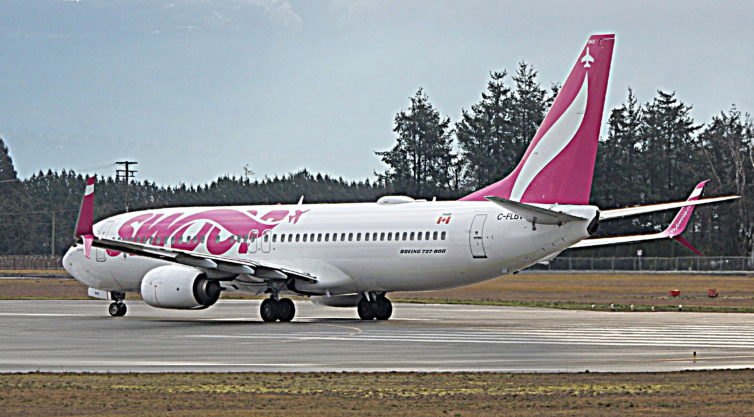
With their new low-cost subsidiary, Swoop, connecting secondary markets, WestJet is able to focus on its joint venture with Delta – Photo: John Jamieson
Some Low-Cost Context
As far as I can remember, Canadians have complained about the cost of domestic air travel. Stuck in an increasingly permanent duopoly, Air Canada and WestJet have been without significant competition for the past 15 years. When JetsGo ceased operations in 2005, the domestic market was handed over to two carriers with little interest in changing the status quo. Moreover, with the ability to control prices and adjust capacity, Canada’s two flag carriers have been able to stifle their competition. Additionally, as a result of the duopoly, the barrier to entry for new market entrants has gone up significantly.
Part of the problem lies in Canada’s geography. With a population smaller than Tokyo spread over an area larger than the United States, it’s no wonder that airlines have struggled to succeed in Canada. While there is considerable traffic between the major urban areas (Vancouver, Calgary, Toronto, and Montreal), there is very little flow between Canada’s smaller cities. This makes profitability a major struggle for new market entrants, especially when the major routes are dominated by Air Canada and WestJet.
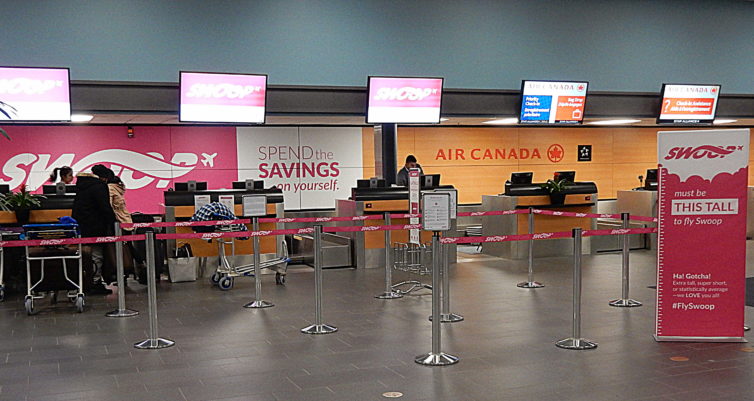
Swoop offers its customers landside check-in; however, many passengers make use of their mobile app – Photo: John Jamieson
Start of the Transition
However, things may be about to change. Three carriers (Rouge, Flair, and Swoop) are currently offering low-fare travel options and a fourth, Canada Jetlines, is on the way. Each with their own identity, the three existing carriers have thus far managed to stay afloat in Canada’s notoriously turbulent market. But for how long? That remains to be seen. With low-cost travel finally taking off, it’s worth taking a closer look at how they’ve managed to attract and maintain business. We’ll be taking a look at their origins, cost structure, and the quirks which have kept them in business and, later in my story, I’ll be including my brief interview with Swoop President Steven Greenway.
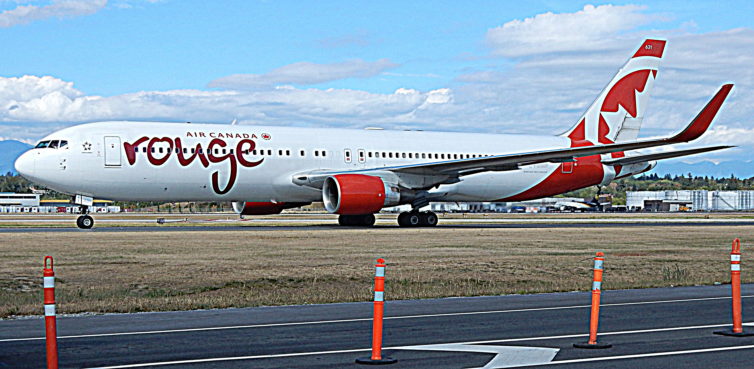
From mainline rotation to vacation configuration. Acquired from Air Canada’s mainline fleet, Rouge has configured their 767-300ER fleet in a 24J (Premium), 256Y (Economy) layout. – Photo: John Jamieson
Rouge: Air Canada’s newest gamble
With their eyes on mainline expansion, Air Canada’s Leisure group became increasingly forgotten as costs started to exceed passenger demand. By 2012, something needed to be done. With Transat, WestJet Vacations, and Sunwing Travel dominating the “Snowbird Sector”, a creative, cost-effective solution became a necessity.
Bonus: Air Canada Rouge-First Flight of a New “Leisure” Airline
Enter Benjamin Smith, Air Canada’s President of Passenger Airlines. If Air Canada was to re-enter the leisure market, Smith realized they would need to reduce their labor and operational costs. However, this wouldn’t be easy. The bulk of Air Canada’s flight attendants and line pilots are currently members of a union group: CUPE (Flight Attendants) or ACPA (Pilots). Consequently, this made negotiating contracts extremely difficult. Also, history was not on Air Canada’s side.
Tango and Zip: Learning from past mistakes
Shortly after merging with Canadian Airlines, Air Canada launched two budget airlines to try and fend off WestJet and Canada 3000. Tango offered low-frill service between Air Canada’s main hubs (Trans-Con Operations) and flew “Snowbirds” down to the southern United States. Zip, on the other hand, primarily competed with WestJet, who at the time was dominating the low-cost sector.
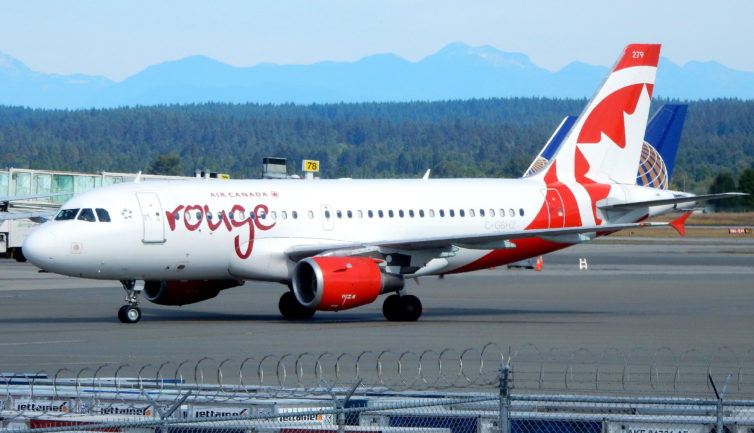
Operating a mixed fleet of A319s and 767s, Rouge expanded to Western Canada in 2014 – Photo: John Jamieson
Bonus: Air Canada rouge Expands to Western Canada
Ultimately, Tango ended up cannibalizing Air Canada’s mainline routes while Zip’s relatively high labor costs inhibited their ability to discount fares. Neither subsidiary had performed to the standards expected by the airlines’ executives. Tango ceased flying in 2003. While the airline ceased operating, the brand remained as a fare class for the parent carrier. Zip, on the other hand, continued operating until September 2004 before terminating service for good. The brand has never resurfaced and Air Canada vacated the low-cost market.
Domestic Expansion: Taking advantage of scope clauses
In their return to the budget sector, Air Canada has struck gold with Rouge. Ben Smith managed to negotiate a fantastic deal for the parent company while also creating something “reasonably” fair for the pilots and flight attendants. The scope clauses negotiated have allowed the airline to expand in the domestic market without imposing on AC’s mainline network.
Crucially, Rouge offers Air Canada something that its Express brand can’t: lower costs with room for capacity growth. Over the past few years, we have seen this manifested in a couple of different ways:
- Adding new cross-country services that were previously been uneconomical
- Bonus: Rouge expands service to Kamloops and Nanaimo via EHviation
- Up-gauging Air Canada Express routes to “mainline” aircraft with higher capacity and lower Cost per Available Seat Mile. This also allows for additional cargo capacity.
- Bonus: Air Canada adding more planes to Rouge for use on domestic routes via CBC News
To date, Rouge has been reasonably well-received by Canadians. Passengers are able to redeem their Aeroplan miles, connect through Air Canada’s global network (interline), and, for a fee, gain access to Air Canada’s Maple Leaf Lounge.
With a long-term strategy in place, Rouge is well-positioned for future success.
Flair Airlines: Turning over a NewLeaf
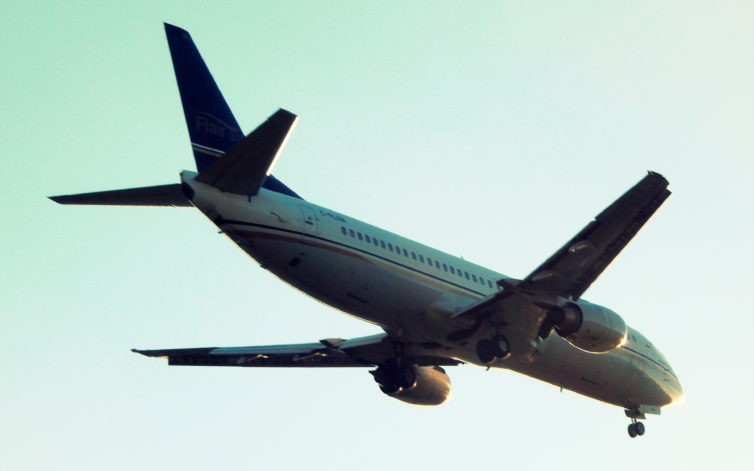
Founded in 2005 as cargo/charter carrier, Flair Airlines incorporated virtual airline NewLeaf on July 25th, 2017 – Photo: John Jamieson
Origins and Context
As we continue our look at Canada’s low-cost carriers, this is definitely the one that you haven’t heard of before. Perhaps the most interesting of the three, Flair Airlines, started operations in 2005 as a charter/cargo operator. Since rebranding and adopting a low-cost business model, Flair has carved out a niche in Canada’s domestic market. While they have achieved some success, Flair continues to face the most adversity. Without the support of a parent carrier, Flair is on its own against Canada’s domestic giants.
Based in Edmonton (AB), Flair’s mixed fleet of 737s is one of the oldest in Canada. With that in mind, the airline is currently in the process of replacing their -400s with leased -800s, something that will continue through 2020. As of right now, their closest competitor is WestJet’s subsidiary Swoop. While on paper they target the same subset of the market, the two carriers actually have very different networks.
Doing things Differently
While Swoop may shout about their nine dollar fares, Flair is arguably doing more to drive down prices. Instead of serving secondary markets, they are trying to reduce fares between mainline destinations. If the carrier can withstand the short-term financial challenges, they have a chance to really establish themselves in the Canadian market.
Bucking the low-cost trend, Flair raised eyebrows when they chose to operate flights into Canada’s two largest airports: Vancouver (YVR) and Toronto (YYZ). When Flair began service between YVR and YYZ, they undercut both Air Canada and WestJet. While the two giants have since responded by slashing fares, Flair continues to operate direct service on a daily basis.
In my opinion, Flair is more in touch with Canadians than Swoop or Rouge: they provide low fares on routes that matter. While Swoop may offer more attractive destinations, Flair is sticking around thanks to the loyalty they’re showing to Canadians.
Swoop: WestJet’s Canadian SPIRIT
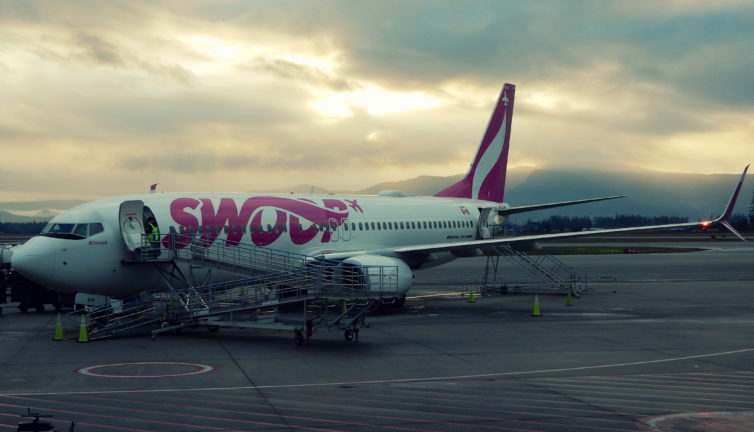
Established as a low-cost fighting brand, Swoop serves secondary markets and caters to millennials – Photo: John Jamieson
Following the demise and acquisition of Canadian Airlines, WestJet started drifting away from its low-cost roots. After quashing the hopes of Montreal-based start-up Jetsgo, WestJet set its sights on Air Canada. If you need a reminder of how the carrier transitioned from a friendly budget carrier to a profit-focused hybrid airline, check out our recent look at WestJet and its partnership with Delta.
Bonus: WestJet: Driven Forward by Delta
In a twist of irony, especially given their new slogan, WestJet’s owners may “Love where they’re going” but Canada’s cost-sensitive travelers certainly don’t.
As WestJet moved closer to Air Canada, a chasm opened up beneath their wings. As they began spurning budget travelers, WestJet’s competitors began to take notice. Air Canada was the first to respond (Rouge), followed shortly by a new market entrant: Flair Air (through the acquisition of Newleaf). All of a sudden, WestJet’s role as a low-cost small-market carrier was in jeopardy. In order to re-establish its position in the low-cost realm, the airline needed a fighting brand with a charismatic, yet competent, individual running the show. Enter Steven Greenway and Swoop.
Men at Work: the man from “Down Under”
Hailing from Australia, Swoop’s inaugural President is a certified “AvGeek.” A longtime Boeing fan (with particular emphasis on the Queen of the Skies), Steven had the opportunity to fly on Cathay Pacific’s final 747 flight in 2016. Having worked for low-cost carriers Virgin Blue (now Virgin Australia) and Singapore Airlines’ ULCC, Scoot, he also knows a thing or two about low-cost operations and e-commerce. During an event in Abbotsford, I had the chance to catch up with Greenway for a quick interview.
Bonus: #EHviationEvent: Abbotsford International Terminal Expansion via EHviation
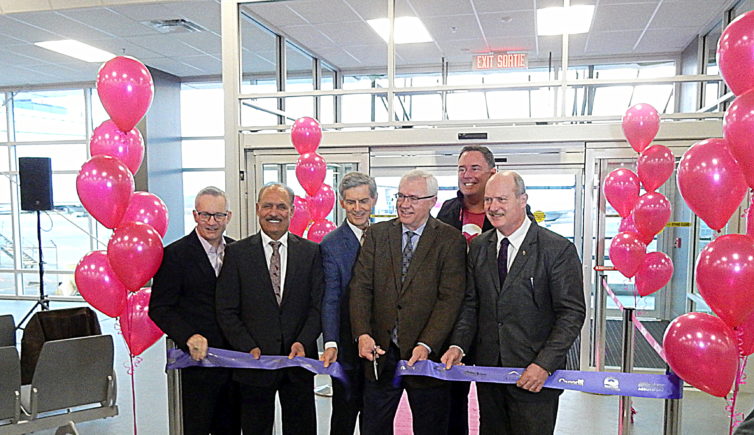
Steven Greenway (back row) pictured alongside other distinguished guests at the Abbotsford Airport Terminal Expansion event in January 2019 – Photo: John Jamieson
Interview With Swoop’s President
John Jamieson (JJ): Hi Steven, thanks for taking the time to meet! We’re here in Abbotsford celebrating the recent expansion of their passenger terminal. For a low-cost airline like Swoop, how important is it to partner with a cost-friendly airport such as Abbotsford?
Steven Greenway (SG): It’s incredibly important from our standpoint. Being able to operate into an airport with reduced landing fees and lower handling expenses, we’re able to pass those savings along to our passengers, while stimulating new traffic for the airport.
JJ: Are there any plans to base any aircraft or establish a crew hub at YXX?
SG: If all of our expansion plans fall into place, we hope to begin basing a couple of 737-800s at YXX later this year.
JJ: Has the airline looked at Abbotsford as a potential connecting hub for destinations to the United States?
SG: Currently, the costs associated with connecting flights don’t offset the potential revenue gains. While this may be re-examined in the future, solidifying our Origin and Destination (O&D) network remains our number one priority.
JJ: Lastly, in October of 2018, we learned that Swoop is to be included in WestJet’s Transborder joint venture with Delta Airlines. Will the airline be actively involved in the “JV” (ie. interlining, shared ground equipment, new services)? and secondly, will there be new emphasis at Swoop as far as entering existing Delta markets in the United States?
SG: As far as our involvement in the Joint Venture is concerned, we’ve opted to explore the agreement’s secondary benefits as opposed to interlining and codesharing. In terms of Swoop exploring new markets in the United States, our primary focus will be on revenue and network scheduling. Additionally, considering the airports we operate from in Canada, we’ll need to determine if those markets can handle international arrivals.
My Canadian LCC Conclusion:
Without having tried Flair or Swoop, I can’t comment on their level of service or the reliability of their operations. While both airlines have been through rocky patches, neither has been forced to make major network cuts. On the other hand, my sole experience with Rouge in 2016 was more or less like my recent experience with United Airlines: unremarkable. While Rouge has been the most successful Canadian LCC in recent years, their base fares remain above Flair and Swoop.
In my opinion, the success or failure of these three carriers rides on the back of middle-class families and millennials. If the airlines can successfully attract new customers and reduce the cost of domestic air travel in Canada, they may stand a chance of being more than a one-year wonder.
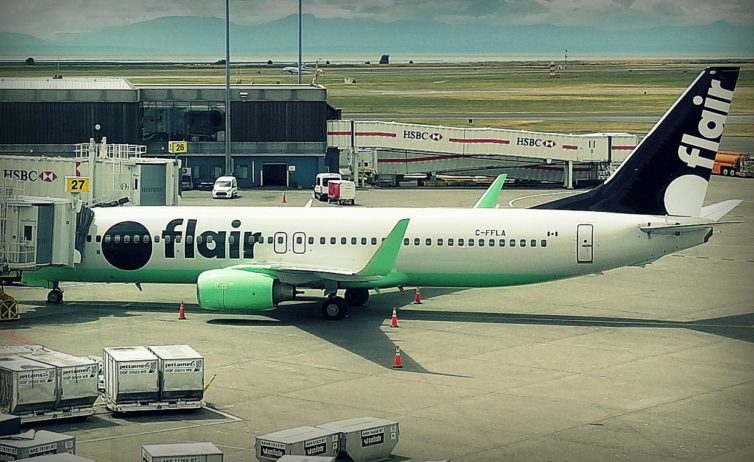
Rouge is a strange beast. It is purely about reducing costs for Air Canada. When a route gets rouged, the prices generally do not change at all. The good thing about Rouge is that it makes certain routes viable that might not otherwise be run at all. The worst thing about Rouge is that some of their aircraft have VERY few extra legroom seats. As a tall person I won’t fly them, and when Air Canada started using Rouge planes to take up the slack after the MAX grounding I avoided booking Air Canada on the off chance that I might be switched to Rouge.
I hope that Flair survives, but I haven’t tried them yet. Flying in to Toronto instead of Hamilton might give them a big advantage over Swoop.
I took a Swoop flight in July, and was perfectly happy with my extra legroom seat. I would fly them again. They have been getting really bad publicity over their poor handling of cancellations lately though. Hopefully they can figure that out.
Fair enough. When I flew with Rouge to Hawaii in 2016, we upgraded to Plus Seating (35-inch pitch compared to 30-inch) from Regular Economy. I found it reasonable for my height (1.85 M/ 6″1′); having never tried the standard economy seat, I can’t really comment on its level of comfort.
I’d say the airline does a reasonable job of providing that kind of information to the passengers. There are also websites that offer additional recommendations. Obviously the airlines know that a portion of their customers are willing to pay for upgrades or ancillary benefits, while the base fare covers the remaining passengers.
After thinking about prices, Rouge’s cost structure certainly allows it to offer lower prices than its parent company… whether that happens is another matter.
As for Flair and Swoop, I noticed that the Canadian Competition Bureau more-or-less dropped the complaint made by Flair regarding Swoop’s pricing. It had been suggested that some of Swoop’s fares were priced below an acceptable level; however, apart from the initial news story, nothing has been heard of the matter since.